Friends of Rio Vista distributes bimonthly bulletins via email and publishes key information from these bulletins here. To start receiving our bulletins, sign up here.
In this issue, we focus on Rio Vista’s staff of life: its plant communities. Now’s a time of great opportunity. The rains came, at last. Community scientists have cataloged and mapped plant species. Volunteers have planted seeds and protected vegetation. And a new project — to transform the trail system with a barrage of native plants — is in the wings. You can help the park ecosystem to make the most of these opportunities.
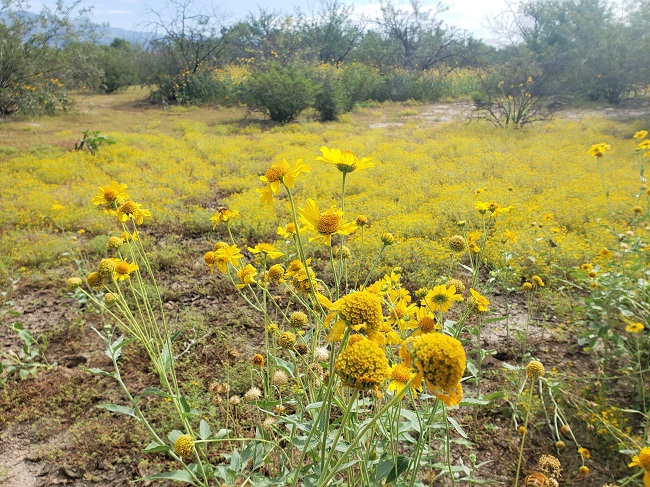
at Rio Vista. Photo credit: Carianne Campbell.
But first, some announcements.
New logo. Thanks to the talent and generosity of park neighbor, graphic designer, and Friends of Rio Vista volunteer Malice Keller, we now have a beautiful new logo, which introduces this issue of the bulletin. Malice has also designed letterhead for the organization. Along with the Friends logo, we’ll continue to use the logo for the Rio Vista Conservation Project, designed by Melanie Campbell-Carter. Thank you so much, Malice and Melanie!
New contact information. We now have a new e-mail address: FriendsofRioVistaNRP@gmail.com. Please remember to include the “NRP” (for “Natural Resource Park”) — otherwise, your message will go to another organization, in California.
New postal address. Friends of Rio Vista, P.O. Box 65693, Tucson, AZ 85728. We’re looking forward to hearing from you!
A Year in the Life of Rio Vista: Update on the Arizona Native Plant Society’s Plant Survey
If you’ve visited Rio Vista Natural Resource Park, you know that plants abound there, but did you know that 101 species of plants have been recorded within its borders? Last year, the Rio Vista Conservation Project invited the Tucson Chapter of the Arizona Native Plant Society to conduct a formal survey of all plants — both native and nonnative — that live there. The survey covered nearly a full year, from June 2020 to April 2021, to provide a plant snapshot of all growing seasons in the park. Although this was one of the driest years on record, Rio Vista’s plants showed resilience. Some plants revealed their survival strategy by failing to put on leaves, flowers, or fruit, yet they were not dead; others took advantage of the scant rainfall we did receive and managed to produce some seed.
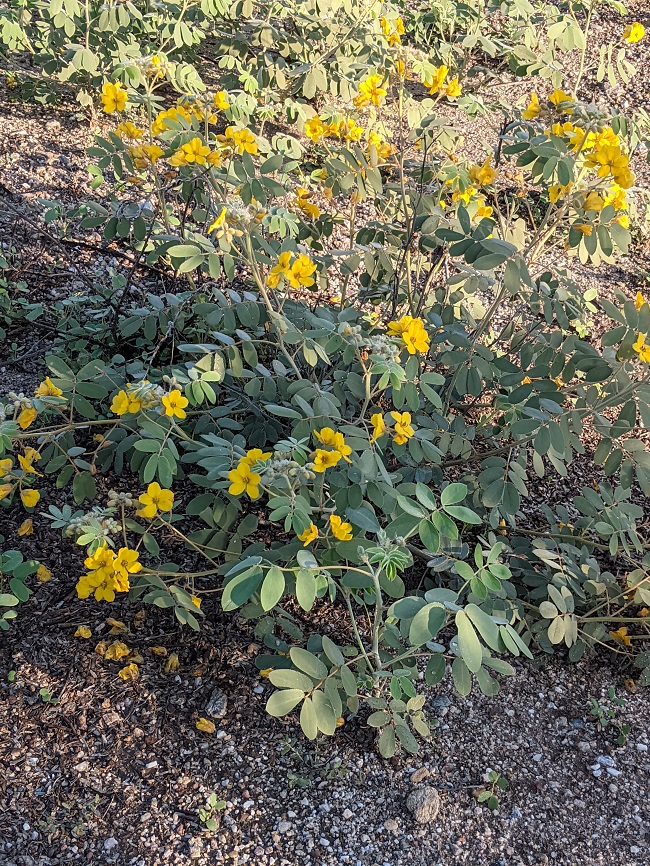
Thank you to the hardy volunteers who braved the heat to survey the park and to Melanie Campbell-Carter and Susan Husband, coordinators of the project. Valuable information was gathered that can be used in future park restoration projects; it also will contribute to the enjoyment and appreciation of the park by visitors.
The Arizona Native Plant Society has done one more survey of the park, in October. Additional plants identified in this survey will be added to the park’s list of plants.
You can view the final report on the 2020–2021 plant survey here. The comprehensive public plant list is available both in the final report and as a separate download here.
From Rogue Trails to Robust Habitat: A New Partnership with Strategic Habitat Enhancements, LLC
Will you join us in realizing a vision of Rio Vista plant communities that are even more vigorous—and that will create even richer habitat for the park’s wildlife?
With the approval of Tucson Parks and Recreation, Friends of Rio Vista has entered into a partnership with Strategic Habitat Enhancements (SHE), for habitat enhancement in the park. The enhancement project is a follow-on to the closures of rogue trails conducted in 2019 and 2020 through the Rio Vista Conservation Project. It will build on the results of the 2020–2021 results of the plant survey by the Arizona Native Plant Society.
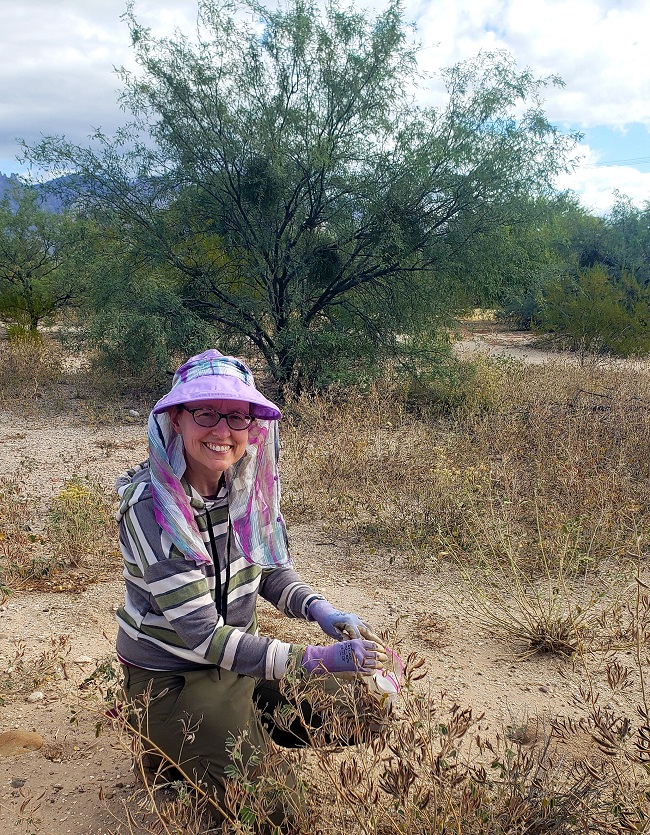
Phase 1 of the enhancement project is the overview plan for “modules” of rehabilitation and definition of the Rio Vista trail system. Carianne Campbell, SHE’s principal, has submitted the draft plan to Friends of Rio Vista. It’s now under review by the Friends board and external reviewers. Once revised, the plan will be submitted to Tucson Parks and Recreation with a request for comments and, ultimately, for approval.
Phase 2 will be the implementation of the final plan — when volunteer opportunities will be plentiful. We’ll welcome your participation in these efforts, from vertical mulching to weeding to hand watering to replacing signs. And that’s just the fieldwork. We’ll need volunteers to identify grant opportunities, to organize the modules before fieldwork, and to measure results. People of all ages and abilities can make a huge difference for the future of Rio Vista.
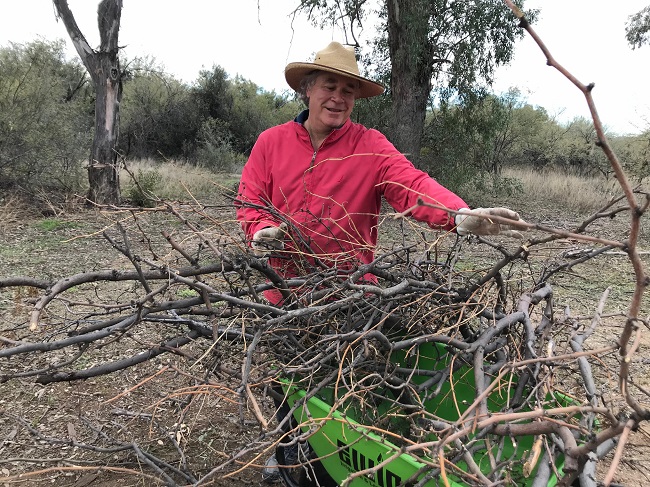
Photo credit: Joyce Bolinger and Melanie Campbell-Carter.
You can also make a difference with a financial contribution. Thanks to an unsolicited gift from a generous donor, more than half the costs of Phase 1 have already been covered. You can show your support for the Rio Vista enhancement project — both phases — with a donation of any amount that fits your budget. All donations are 100 percent tax deductible. Checks made out to Friends of Rio Vista can be sent to our new postal address.
So many of you have already given so much of yourselves for the park and its wild inhabitants. We know that we can count on you to make the dream of a model natural resource park come true.
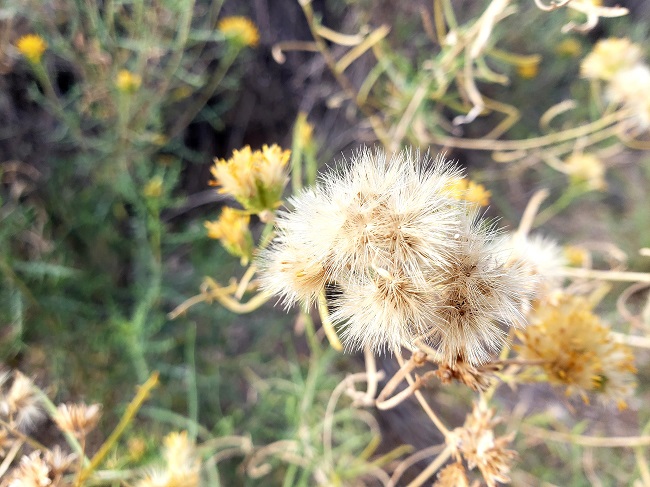
Photo credit: Carianne Campbell.
Giving Mother Nature a Boost: Planting Palo Verde Seeds at Rio Vista
The blessing of rain to our parched park was especially sweet this summer after such a long dry spell. Thanks to a generous offer of technical assistance from John Scheuring of the Arizona Native Plant Society, Friends of Rio Vista arranged for Tucson Parks and Recreation’s approval to plant seeds of foothills palo verde (Parkinsonia microphylla) at Rio Vista. On two moist mornings in July and August, volunteers from the two organizations gathered to plant these seeds. This activity was an outgrowth of the Arizona Native Plant Society’s plant survey requested by the Rio Vista Conservation Project.
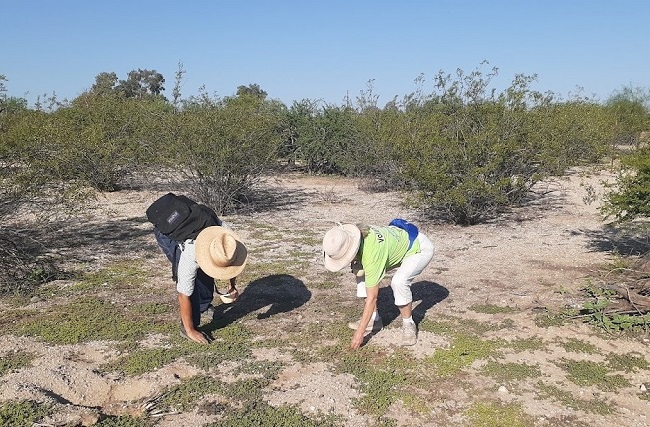
Photo credit: John Scheuring.
The seeds, gathered from the park and nearby areas, were planted one-half to one inch deep, in holes made with a digging bar. These trees usually grow in areas with a slight slope or elevation change rather than on totally flat ground. Even though the park’s landscape appears to be quite flat, on closer inspection, areas with slight swales or berms can be identified, and these areas were targeted. More than a pound of seeds was planted.
We hope that, in a few years, seeds planted during this fieldwork will be on their way to bolstering the foothills palo verde population at Rio Vista. This species is more resistant to drought than blue palo verde (Parkinsonia florida), which is also present in the park.
Trail Signs: The Next Generation
Monsoon rains were heaven for the park ecosystem — and the opposite for barriers to rogue trails. Sawhorses are sagging, and signs are fading. These trail barriers were never intended to be permanent, and the SHE habitat enhancement project will give us new solutions. Meanwhile, many thanks to…
- park neighbor Golda Velez and long-distance supporter Doug Reynolds (all the way from Utah) for helping to replace some of the signs
- Hank Rowe, who’s recently moved to this part of Tucson and who donated a suite of metal signs that we hope to use as directionals
- all the park visitors who’ve set sawhorses back up after they’ve been knocked or blown over
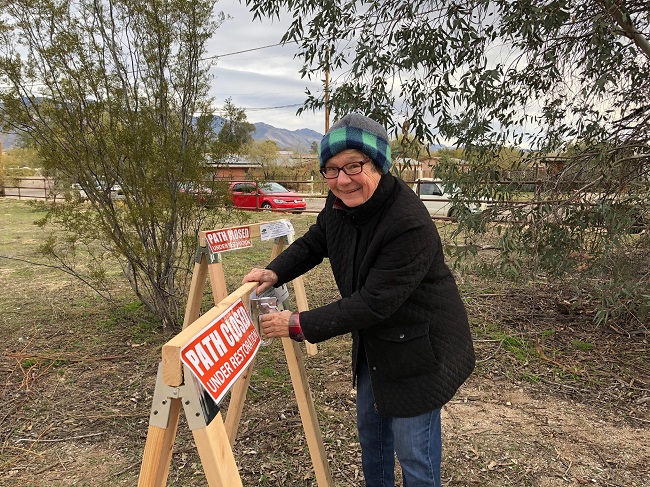
Photo credit: Melanie Campbell-Carter.
We’re looking forward to the day when artificial trail barriers are only memories and rogue paths have disappeared under a bounty of native plants.
